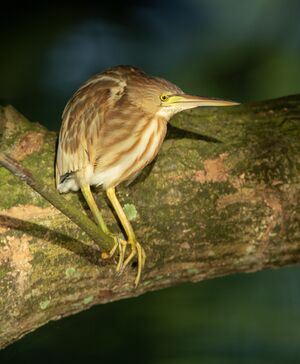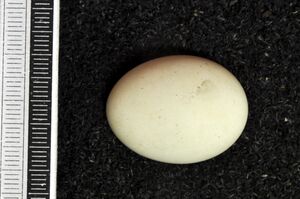واق أصفر
| واق أصفر | |
|---|---|

| |
| التصنيف العلمي | |
| أصنوفة غير معروفة (أصلحها): | Ixobrychus |
| Species: | Template:Taxonomy/IxobrychusI. sinensis
|
| Binomial name | |
| Template:Taxonomy/IxobrychusIxobrychus sinensis (Gmelin, 1789)
| |
الواق الأصفر ( yellow bittern ؛ Ixobrychus sinensis) هو واق صغير. It is of Old World origins, breeding in the northern Indian Subcontinent, east to the Russian Far East, Japan and Indonesia. It is mainly resident, but some northern birds migrate short distances. It has been recorded as a vagrant in Alaska and there is a single sighting in Great Britain, from Radipole Lake, Dorset on November 23, 1962 – however, the British Ornithologists' Union has always considered this occurrence to be of uncertain provenance and currently it is not accepted onto the official British List.
. . . . . . . . . . . . . . . . . . . . . . . . . . . . . . . . . . . . . . . . . . . . . . . . . . . . . . . . . . . . . . . . . . . . . . . . . . . . . . . . . . . . . . . . . . . . . . . . . . . . . . . . . . . . . . . . . . . . . . . . . . . . . . . . . . . . . . . . . . . . . . . . . . . . . . . . . . . . . . . . . . . . . . . .
التصنيف
The yellow bittern was formally described in 1789 by Johann Friedrich Gmelin in his revised and expanded edition of Systema Naturae. He placed it with the herons, cranes, storks and bitterns in the genus Ardea and coined the binomial name Ardea sinensis.[2] Gmelin based his description on the "Chinese heron" that had been included by the English ornithologist John Latham in his multi-volume work A General Synopsis of Birds. Latham based his description on a collection of Chinese drawings.[3] The yellow bittern is now one of ten species placed in the genus Ixobrychus that was introduced in 1828 by the Swedish naturalist Gustaf Johan Billberg.[4][5] The genus name combines the Ancient Greek ixias, a reed-like plant and brukhomai, to bellow. The specific epithet sinensis is Modern Latin meaning "China".[6] The species is monotypic: no subspecies are recognised.[5]
الوصف
The yellow bittern is a small species at 36 to 38 cm (14 to 15 in) in length, with a short neck and longish bill.[7][8] It has yellow green legs, an ivory bill (darker on top), a short black tail and yellow irises.[9][10] The male of the species has a dark cap, chestnut head and neck, with a uniformly dull yellow body above and buff below.[8][11] The female's cap, neck and breast are streaked, with a rufous hindneck and upper back and streaked dark red brown and buff under parts.[9] The juveniles of the species resemble the female but is more boldly streaked, brown on its head and back, and mottled with buff above.[8][9][12]
التوزع والموئل

Yellow bittern's are found in fresh water marshes and swamps.[9] It nests in small constructed platforms of reeds or twigs in the vegetation of reed beds or in trees and shrubs adjacent to or above water.[9][11][13] They lay four to six pale blue-green eggs.[13][14]
السلوك والبيئة
Yellow bitterns feed on a variety of insects, fish, amphibians, crustaceans and molluscs.[14]
الحفاظ
The yellow bittern is protected under the Migratory Bird Treaty Act of 1918.[15][16]
المراجع
- ^ BirdLife International (2016). "Ixobrychus sinensis". IUCN Red List of Threatened Species. 2016: e.T22697303A93606843. doi:10.2305/IUCN.UK.2016-3.RLTS.T22697303A93606843.en. Retrieved 25 October 2021.
- ^ Gmelin, J. F. (1789). Systema naturae per regna tria naturae : secundum classes, ordines, genera, species, cum characteribus, differentiis, synonymis, locis (in Latin). Vol. 1, Part 2 (13th ed.). Lipsiae [Leipzig]: Georg Emanuel Beer. pp. 642–643.
{{cite book}}: CS1 maint: unrecognized language (link) - ^ Latham, J. (1785). A General Synopsis of Birds. Vol. 3, Part 1. London: Printed for Leigh and Sotheby. p. 99.
- ^ Billberg, Gustaf Johan (1828). Synopsis Faunae Scandinaviae (in Latin). Vol. 1 Part 2: Aves. Holmiae: Ex officina typogr. Caroli Deleen. p. 166.
{{cite book}}: CS1 maint: unrecognized language (link) - ^ أ ب Gill, F.; Donsker, D.; Rasmussen, P., eds. (2022). "Ibis, spoonbills, herons, Hamerkop, Shoebill, pelicans". IOC World Bird List Version 12.2. International Ornithologists' Union. Retrieved 25 November 2022.
- ^ Jobling, J. A. (2010). The Helm Dictionary of Scientific Bird Names. London: Christopher Helm. pp. 208, 357. ISBN 978-1-4081-2501-4.
- ^ Silva Wijeyeratne, Gehan de (2008). A photographic guide to birds of Sri Lanka. Internet Archive. London : New Holland. ISBN 978-1-84773-318-4.
- ^ أ ب ت "Ixobrychus sinensis, Yellow bittern". Thai National Parks (in الإنجليزية). Retrieved 2024-04-01.
- ^ أ ب ت ث ج "HeronConservation » Yellow Bittern" (in الإنجليزية الأمريكية). Retrieved 2024-04-01.
- ^ Phillipps, Quentin; Phillipps, Karen (2010-01-07). Phillipps Field Guide To The Birds Of Borneo. John Beaufoy Publishing. p. 60. ISBN 978-1-906780-10-4.
{{cite book}}: CS1 maint: date and year (link) - ^ أ ب Pratt, H. Douglas (Harold Douglas) (2008). The birds & bats of Palau. Internet Archive. Honolulu, HI : Mutual Pub. pp. 164–165. ISBN 978-1-56647-871-7.
- ^ "Yellow Bittern". Birds of Singapore (in الإنجليزية الأمريكية). 2016-01-09. Retrieved 2024-04-01.
- ^ أ ب "Yellow Bittern". Animalia. Retrieved 2024-04-01.
- ^ أ ب "Yellow Bittern (Ixobrychus sinensis) – Planet of Birds" (in الإنجليزية الأمريكية). Retrieved 2024-04-01.
- ^ "List of Birds Protected by the Migratory Bird Treaty Act (2023) | FWS.gov". www.fws.gov (in الإنجليزية). 2020-04-26. Retrieved 2024-04-01.
- ^ "10.13 List of Birds Protected by the Migratory Bird Treaty Act". National Archives Code of Federal Regulations. Retrieved 2024-04-01.
